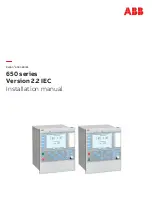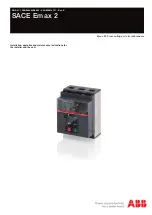
Instruction
Book
Page 36
IB131009EN
5-5 MISCELLANEOUS
5-5.1 EARTHING CONTACT (DRAWOUT TYPE)
The earthing contact is an assembly of spring loaded
fingers providing a means for earthing the breaker chas-
sis when it is inserted into the switchgear compartment.
An extension of the switchgear earth bus is secured to
the compartment in such a position to engage the earth-
ing contact when the breaker is racked into the struc-
ture. It remains engaged until the breaker is withdrawn.
5-5.2 OPERATIONS COUNTER
All breakers are equipped with a mechanical operations
counter. As the breaker opens, the linkage connected to
the pole shaft lever advances the counter reading by
one (Figures
3-2 and 3-3
).
5-6 LEVERING MECHANISM
The purpose of the levering device is to move the break-
er into and out of the CONNECTED position. For W-
VAC and W-VACW breakers, the mechanism is com-
prised of a drive screw and nut. The mechanism is a
part of the carriage assembly or the cradle assembly,
not the basic breaker element (Figures
3-5,3-6 and 3-7
).
The levering device MUST be operated by the use of an
approved levering tool. The tool must be approved to
ensure the proper operation of interlocks. If an unap-
proved tool is used, damage may occur to various com-
ponents.
5-7 CIRCUIT BREAKER INTERFACING
ADDITIONS TO THE BREAKER ELEMENTS AS SUP-
PLIED BY EATON MUST BE MADE IN KEEPING
WITH APPLICABLE IEC STANDARDS. UNDER NO
CIRCUMSTANCES, HOWEVER, SHOULD
ALTERATIONS TO THE SUPPLIED BREAKER ELE-
MENT BE MADE UNLESS THE ALTERATION IS
SPECIFICALLY ADDRESSED AND PERMITTED BY
THIS INSTRUCTION BOOK. ADDITIONS, CHANGES
OR ALTERATIONS MADE THAT ARE NOT SPECIFI-
CALLY ADDRESSED IN THIS INSTRUCTION BOOK
AND NOT IN KEEPING WITH APPLICABLE IEC
STANDARDS AND ACCEPTED ELECTRICAL PRAC-
TICES COULD RESULT IN EQUIPMENT DAMAGE,
INJURY OR DEATH.
5-7.1 ELECTRICAL CLEARANCES
It is the responsibility of the customer to insure that the
proper electrical clearances are maintained on the cir-
cuit breaker, in the assembly structure, and between the
Figure 5-9 Closeup of Type W-VACW breaker vacuum
interrupters and current carrying system
circuit breaker and its assembly structure, whether the
circuit breaker being used is a drawout or fixed configu-
ration. These electrical clearances must be in keeping
with the applicable IEC Standard and the specific with-
stand voltage level of the application.
5-7.2 INTERPHASE BARRIERS
Applicable standards require specific minimum air space
clearances between poles for specific withstand voltage
application levels. It is the customer’s responsibility to
insure that proper interphase barriers are in place on all
circuit breakers prior to inserting a drawout circuit break-
er into a cell, permanently mounting a fixed circuit
breaker and/or placing a circuit breaker in service.
The W-VACR fixed circuit breaker, for example, requires
that interphase barriers be in place between each pole
unit before being placed in services.
It is the cus-
tomer’s responsibility to supply the appropriate bar-
riers and insure they are appropriately installed.
All
interphase barriers must be designed to fulfill the IEC
requirements. They must be constructed of an appropri-
ate insulating material, such as a one-eight inch (3.2
mm) thick high strength, track-resistant, glass-mat poly-
ester.
WARNING
Summary of Contents for W-VAC Series
Page 2: ......
Page 40: ...Instruction Book Page 34 IB131009EN Figure 5 7 Typical DC and AC control schemes...
Page 61: ......











































